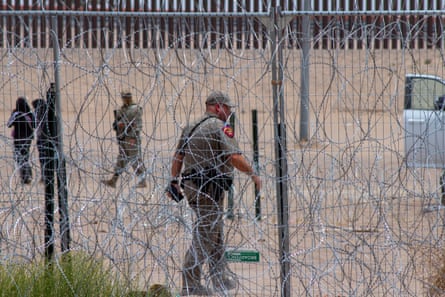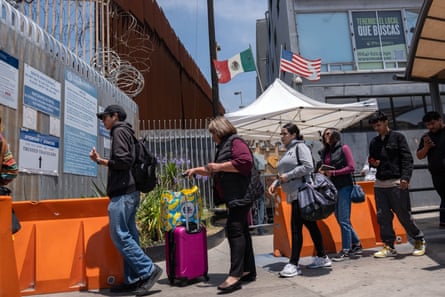Asylum-Seekers at the US-Mexico Border Worry About Their Next Move: ‘We Cannot Return’

Angel Ramos Girón was searching for a gap to breach the coils of concertina wire standing between him and the huge US fence near gate 36.
The port of entry divides the US from Ciudid Juárez in Mexico, where he stood on Tuesday afternoon looking towards El Paso, its American sister city in Texas.
At that moment, he was sitting under a small bush just south of the Rio Grande that marks the US-Mexico border, trying to get a moment of relief from the heatwave that has prompted warnings of 107F temperatures this week.
The 27-year-old from Tegucigalpa, Honduras, had been trying to figure out for the past week how to cross into the US without authorization and ask for asylum. He’d planned to get through the now-ubiquitous razor wire that day but had just found out that everything had changed.
Girón and other migrants standing near gate 36 were in a state of shock when told by a reporter on Tuesday afternoon that Joe Biden had just announced a new executive order to close the border to asylum seekers entering the country illegally if numbers get too high – and it would take immediate effect.
“I’m screwed,” he said in Spanish, dismay on his face. “I don’t know what to do and I don’t have any money, anything left.”

A man waits for US border patrol after crossing the US-Mexico border in Jacumba, California. Photograph: Allison Dinner/EPA
The new order is designed to temporarily block all requests for asylum once the average number of daily encounters of people crossing outside lawful ports of entry reaches 2,500. The border would reopen only once that number falls to 1,500. It was not immediately clear how federal agents dotted along the almost 2,000 miles of the US-Mexico border, which crosses four US states, will know the tally has been reached and refuse to accept an asylum request from someone turning themselves in and asking for protection under international law.
According to the White House, migrants who want to seek asylum legally will have the opportunity to use the US Customs and Border Protection’s CBP One mobile app to schedule an appointment with US authorities.
It sounds simple, but there are fewer than 1,500 appointments issued a day and many thousands of people trying to obtain one. Some wait months just south of the border, often sleeping rough or in overcrowded shelters, trying every day without success. And the app has also had technical glitches.
“Honestly, we did not consider using it. Besides, it would take forever to get an appointment,” said Salome Hernandez, who was standing just south of the border, not far from Girón, with her little sister, mother, cousin and grandfather.
The 20-year-old and her family had to flee from Medellín, Colombia, in late May, she said, after her grandfather received death threats for being a leader of the Community Action Board, a social organization there.
Hernandez’s grandfather, who did not give his name for safety reasons, said that men in military fatigues gave him an ultimatum – to drop his environmental activism to stop deforestation in a natural reserve in the Valle del Cauca and Riseralda region, or face being killed.

People trudge through the brush in Ciudad Juárez near the US-Mexico border. Biden’s restrictions would cap asylum applications at 2,500 a day. Photograph: Anadolu/Getty Images

Texas national guard and state police prepare to prevent crossings from Ciudad Juárez, Mexico, after Biden signed an executive order restricting border crossings. Photograph: Anadolu/Getty Images
“We do not have a plan, and we cannot return,” the 64-year-old man said, upon learning about the new executive order. “This is a low blow.”
Hernandez’s cousin, Eduardo, said he was going to persuade his family to cross illegally into the US through New Mexico’s desert to the west of Ciudad Juárez and El Paso.
The desert anywhere along the border can be dangerous, but just last weekend border patrol reported four deaths of migrants from heat and dehydration in that very stretch of desert Eduardo was now desperately contemplating.
Eduardo said he was hoping the group could get to New York or Denver, where they have family. He asked if Denver was walkable. It’s about 650 miles away.
Across the north side of the river, on US soil but up against the huge fence, wire and a closed gate, was a group of about 20 people, hoping to get through but also now no longer able to request asylum without an official appointment, as daily numbers have been much higher than 2,500 people. There was no shade and they had been in the blasting sun for hours, with kids and at least one baby visible among the group.
Ramos Girón also said the desert is now his last resort. “I’ve gone through a lot to get here. The sun doesn’t scare me,” he said.
He had been working odd jobs the past two months since he arrived in Mexico to support himself and save money to send back to his wife, nine-year-old girl and a 17-month-old baby boy he left behind in Honduras.
The 150 Honduran lempiras, about $6, that he earned daily as a farmer in Honduras harvesting coffee beans and corn did not cover the basic needs to support his family, he said.
“I prefer to die trying than for my family to die of hunger,” Girón said.
In contrast to the shock and desperation apparent on the Mexican side of the border on Tuesday, warned about by experts and railed against by progressives, the US side appeared calm.
Biden’s immigration order: a re-election bid that could result in ‘suffering and death’
More than 700 miles west of El Paso, at the San Ysidro port of entry between Tijuana in northern Mexico and California just south of San Diego, it was business as usual.
This corridor is one of the busiest land crossings in the world, and the San Diego sector has seen a large increase in people seeking asylum over the last few months.

People walk to cross at the San Ysidro crossing port on the US-Mexico border, as seen from Tijuana, Mexico, on 4 June. Photograph: Guillermo Arias/AFP/Getty Images
But on Tuesday it was calm, and families and individuals who live in the area were going about their business, many walking across the bridge that connects the two countries. Red trolleys at the San Ysidro transit center waited to take passengers to other cities in southern California, and groups of people filtered in and out of the small shops near the border, changing cash at money exchange stores and ordering food at McDonald’s.
For many, walking or driving across the border is a regular part of their week.
Abel Walser, a 26-year-old from Oceanside who has Mexican heritage, was crossing into the US with a friend around noon. “This country was built to be a melting pot” he said, adding that he knows people who initially came to the US illegally but have since endured the extremely difficult, years-long process to become a US citizen.
For Gustavo Rodriguez, who lives in Tijuana but was born in San Diego, the president’s order was good news. “I feel that it’s getting out of hand,” he said of recent immigration numbers. “Unfortunately, maybe there are some people who really need , but we’re just getting swamped with people.”
Meanwhile, Erika Palomo was passing through the palm tree-lined transit center on her way back to the Mexico side.
“I’ve seen all the people trying to cross and get better opportunities, especially kids,” she said. “It’s a lot of people.” But she added that she believed mothers and children should be given extra consideration when it comes to asylum.
On the Tijuana side of the border, cars waiting to enter the US were lined up as far as the eye could see. Men and women hawked churros, candy and Mexico-themed trinkets to the drivers. The passport checkpoint was brisk, but a different line could be seen, a few dozen people presumably without documentation, waiting with suitcases and pressed against a wall for a scrap of shade. Their fate was far less certain even than it had been 24 hours before.
